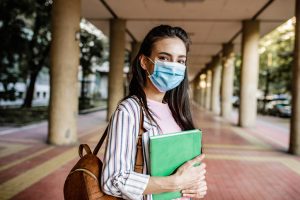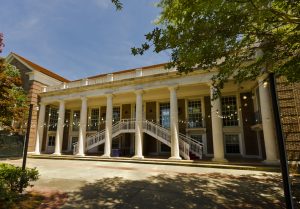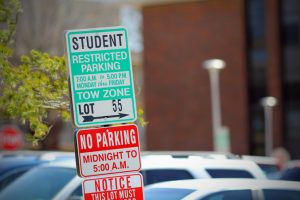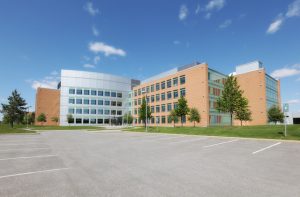 By Ryan J. Givens, CAPP
By Ryan J. Givens, CAPP
The unusual parking challenges faced at Penn State (and the creative solutions that worked) when a new ice arena was constructed on campus.
What university wouldn’t love a brand-new ice arena for its hockey team? While it was certainly exciting (for all the right reasons) when Penn State opened its new facility more than two years ago, the arena also presented unusual challenges when it came to parking. Fortunately, it was nothing a little creative thinking couldn’t solve.
In September 2010, Terry and Kim Pegula donated $88 million to The Pennsylvania State University—the largest private gift in the university’s history—to fund a state-of-the-art, multi-purpose ice arena that would help establish NCAA Division I men’s and women’s hockey programs. In 2012, during the groundbreaking ceremony, it was announced that the donation amount had increased to $102 million. The money covered additional construction costs for the arena, operational costs, and some additional scholarships.
I did not start my employment with Penn State until January 2012, but as a lifelong hockey fan, I was already well aware of the pending construction of the arena and very excited to know I was moving to an area where there would be Division I hockey programs just a short drive from my new home. But as a parking professional, seeing the final site selection for the new arena brought on some serious concerns and worries. These concerns and visions of challenging parking situations emerged before I’d really begun to understand the ins and outs of the campus parking program and day-to-day parking requirements at Penn State.
The Arena
Allow me to paint a picture of where the Pegula Ice Arena (PIA) was built in relation to other campus buildings and facilities. In many ways, the eastern side of the University Park campus is a large athletic compound. To the south of PIA is Holuba Hall, an indoor practice facility for many of the sports teams; the Lasch football complex; an indoor and outdoor tennis complex; and the East Area Locker Rooms Building, which houses many of the sports teams’ locker rooms along with training and rehabilitation facilities. Located to the west of PIA is the field hockey complex and beyond that, the natatorium (swimming pool facility). To the north of PIA is the recently renovated and expanded Intramural (IM) Building, and to the east is the Bryce Jordan Center (BJC), which hosts the Penn State basketball teams, concerts, and other events. Just past that to the northeast is the 107,000-seat Beaver Stadium. Also in the vicinity of PIA are several other sports facilities, the military ROTC building, and the building that houses the admissions and bursar’s offices.
Most of the parking lots close to PIA are primarily permitted faculty and staff parking areas, with a few larger commuter parking lots in the vicinity as well. The faculty and staff lots are allocated to around 107 percent and reserved for permit holders to either 5 or 9 p.m., Monday through Friday. That higher allocation level still provides us the ability to handle daily permitted parking demand. PIA is open to the public daily from 8 a.m. until 10 p.m., sometimes opening even earlier and staying open later than posted operations hours. Daily activities inside PIA include public skate times, ice skating classes, other ice programs, a coffee club, youth and adult hockey leagues, small conferences, meetings, luncheons, and other regular events. The lots around PIA are permitted, so the most significant day-to-day challenge is providing enough parking for PIA patrons so they have a positive customer experience while ensuring our permit holders can still find spaces. One of the most important things we strive to do within transportation services is ensure that everyone who comes to campus has a positive experience. We do not want to be the reason a patron of the PIA, the campus hotels, or any other facility or venue does not return.
While PIA was under construction, we already were giving strong consideration to adding multi-space pay stations at selected locations on campus. One unique situation we faced was that one of the lots adjacent to PIA is the primary lot for the daily customers of the admissions and bursar’s offices. Additionally, many of our faculty and staff permit holders had voiced preemptive concerns about how PIA was going to affect the availability of parking for them, their personnel, and their daily customers. Knowing where we could assign PIA patron parking and in what amounts, we determined the best way to immediately address these issues was by moving forward with the plan to add multi-space pay stations strategically around PIA, which we did in late 2013. Depending on the lot regulations and number of additional daily patrons we could handle, we set up the multi-space pay stations either on a pay-by-space basis to limit parking to one-hour or pay-by plate in lots where we could handle large volumes and allow longer transient daily parking.
Meeting Challenges
For the most part, deployment of the pay stations, along with significant communications efforts, have worked very well and minimized most potential day-to-day conflicts. There have been two recurring situations, no matter our efforts, that lead to the majority of parking citations issued in the area:
- Inside the arena is a well-known sub sandwich chain. Many customers knowing or thinking they are only going to be inside 15 to 30 minutes choose to gamble and risk not paying the $1 hourly rate at the pay station. Unfortunately, those visits often end with someone’s sandwich becoming quite expensive.
- The faculty and staff lot with multi-space pay stations is reserved until 5 p.m.—not 9 p.m. like other facilities. Some PIA patrons and campus visitors take a chance that they will not receive a ticket between 4:30 and 4:59 p.m. Many have found through experience that this is not the case. We have to continually use directed enforcement in this area to garner better compliance and keep it from becoming an overwhelming issue.
An interesting situation that we’re glad has only happened a few times occurs when PIA patrons use the pay station before entering the building; once there, they find out the public skate or class has been cancelled. These patrons want to be reimbursed for the hour or two of parking they paid for prior to entering the arena. Needless to say, this has resulted in some very interesting conversations with upset patrons and PIA staff. Even though our office wasn’t responsible for the mix-up, we’ve tried to be good partners and work to come up with solutions for each situation.
Some of these situations may be unique to a campus ice arena, but for the most part, the challenges we have faced are not much different then what many other universities face on a daily basis somewhere on campus. Parking for men’s hockey games, though, is really where more of our challenges have existed.
Game Day Parking
PIA holds a maximum capacity of approximately 6,100 patrons for each hockey game. Without competing events in surrounding venues nearby, there is more than ample parking within the vicinity of the arena to handle the demand. One of the specific event-parking challenges is that three of the lots designated as premium hockey game parking are reserved faculty and staff lots during the day; this includes the lot that serves the admissions and bursar’s offices. Changeovers from daily employee parking to premium parking on event nights required a limit to be placed on the number of hockey premium parking permits that were distributed. We worked very closely with Penn State Intercollegiate Athletics (ICA) to develop the initial premium parking permit distribution numbers and continue to work with ICA prior to each season to determine if modifications are needed.
We also knew that for games that started after early afternoon, it is often dark, cold, and windy, and there are overlapping events during hockey games. A solution was needed that created visibility for police officers and parking attendants as vehicles approached, sim plicity for season-ticket holders, and less exposure to the elements for our parking attendants on cold evenings and afternoons. Frank Pope, event parking coordinator, came up with an excellent concept for our three hockey premium parking lots: a game-specific, lot-specific, oversized hangtag made of reflective material that incorporates a detachable voucher that is collected by event parking attendants. These hangtags have worked so well for men’s hockey that a similar hangtag is now in use for the special parking areas for men’s and women’s basketball.
Building In More
When a nearby commuter lot was expanded, we took the opportunity to add more than 50 magnetic plates and Gorilla Post space delineators in the lot. These have not only allowed us the flexibility and ability to properly size the space we capture for Americans with Disabilities Act-parking patrons and premium overflow, but additional plates added later allow us the ability to control traffic flow out of some specific lots. This was very important in one of the lots during changeover from daily employee parking to premium parking, when failing to control the direction of exiting traffic added congestion and wait times to both the exiting and incoming vehicles. The posts are now used in several event lots and for many different events.
Addressing parking for hockey and a new arena required us to take our event parking planning to a new level as constant adaptability, creativity, and innovation became increasingly necessary pieces of our event parking operations. Never before did we need a tiered event-parking rate. Those attending non-athletic events without permits or vouchers paid $10 per vehicle; athletic event parking cost $5 per vehicle. Last season and again early this year, we anticipated almost sellout crowds—more than 15,000—attending a non-athletic event and a PIA sellout crowd of 6,100 for men’s hockey.
We put in place a tiered system for these events: $10 per vehicle in lots immediately adjacent to the events and $5 per vehicle to park in two parking decks about a quarter mile to the west. Hockey patrons are used to only paying $5 per vehicle so this was a change for them. The tiered rate was implemented to incentivize people to park farther away for a lower rate and try to spread out the parking through more locations to help ease the stress placed on the roadway infrastructure on and near campus. Spreading more parking to the west better allows university police officers to direct traffic in opposite directions post-event, rather than having thousands of cars try to exit in the same direction.
Creative Thinking
A typical hockey weekend consists of a Friday evening game and Saturday afternoon game that starts sometime between noon and 4 p.m. Several weeks ago, we had to take unusual steps to ensure that premium hockey parking would be available for the Saturday game; also scheduled that day were a men’s basketball game in the BJC, an all-day swimming event in the natatorium, an all-day volleyball tournament in the IM Building, and non-varsity hockey games on both ice rinks in PIA prior to the men’s game, plus several other smaller events. With so many events taking place, it would be very difficult to maintain premium hockey parking. We could have selected to staff the event lots very early in the morning, but this would lead to hours of many face-to-face discussions involving our event staff personnel being yelled at, which would be an onerous and unfair situation for them.
After much deliberation, we decided to communicate that we would be securing and locking those lots about an hour after the Friday night game. They would then reopen only after event-parking personnel staffed their positions for the Saturday game. Through the efforts and collaboration of our department, intercollegiate athletics department, and university police, we distributed the information, put up the necessary signage, and put in place steps to be taken if a vehicle was locked in one of the lots overnight. The new system was a huge success, with the only real complaint being from a basketball patron who was upset he could not park in one of these lots for free.
We continue to learn, adapt, and use creativity and innovation as opportunities present themselves. To date, we have conducted event parking for 48 Penn State men’s hockey games. The tremendous efforts of our event parking team and collaboration with others have successfully allowed all patrons to park in their respective lots for 47 of those games. We are not pleased that for one particular game all of the conflicting circumstances resulted in some customers having a less-than-positive customer experience. However, we are very proud of the constant professionalism and efforts displayed by our team, the learning-moment opportunities presented that we have capitalized on, and the overall high level of exceptional customer service we provide to our customers and our partners, ICA, PIA, and the BJC. If you ever have an opportunity to be in Hockey Valley during
hockey season, please come to a game. We would be happy to park you.
RYAN J. GIVENS, CAPP is associate director of transportation services at The Pennsylvania State University. He can be reached at rjg22@psu.edu.
TPP-2016-03 Ice Parking
 By Brett Wood, CAPP, PE
By Brett Wood, CAPP, PE
 Experts say micro-mobility will emerge as a major form of transportation, especially in cities and on campuses, as we re-open after COVID-19. How do you think the industry could best take advantage of this trend?
Experts say micro-mobility will emerge as a major form of transportation, especially in cities and on campuses, as we re-open after COVID-19. How do you think the industry could best take advantage of this trend?
 Colleges and universities are facing unprecedented challenges this fall: To return to campus, to stay all-remote, to launch a hybrid model, and everything all of those decisions entail. Health and safety have never played as big a role in a fall as they do this year, and that means parking and mobility departments are having to rethink almost everything–including what decreased revenue means.
Colleges and universities are facing unprecedented challenges this fall: To return to campus, to stay all-remote, to launch a hybrid model, and everything all of those decisions entail. Health and safety have never played as big a role in a fall as they do this year, and that means parking and mobility departments are having to rethink almost everything–including what decreased revenue means. By Matt Penney, CAPP
By Matt Penney, CAPP
 By Perry Eggleston, CAPP, DPA
By Perry Eggleston, CAPP, DPA